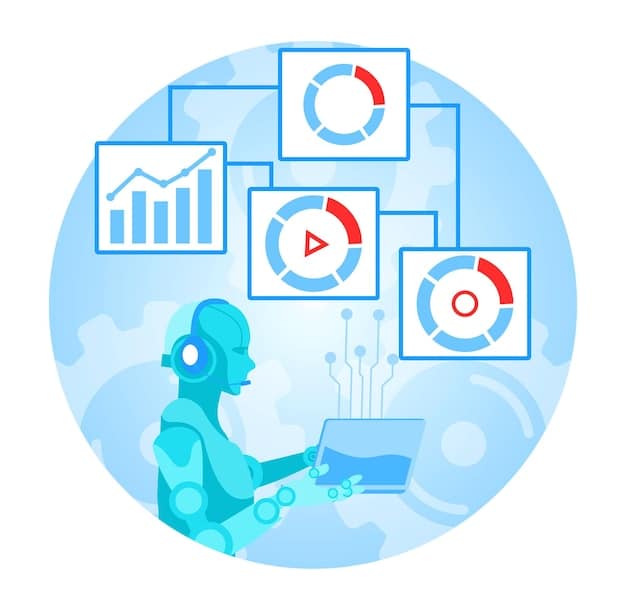Automate Customer Service: How US Businesses Can Save 30% with AI by 2025

US businesses can potentially automate 30% of their customer service tasks using AI by 2025, leading to cost savings, improved efficiency, and enhanced customer experiences through chatbots, personalized support, and predictive analytics.
Is your business ready for the AI revolution in customer service? By 2025, the possibilities for automation are set to explode, potentially allowing **How US Businesses Can Automate 30% of Customer Service Tasks with AI by 2025**. This transformation isn’t just about technology; it’s about redefining how you connect with your customers and drive efficiency.
The AI-Powered Customer Service Revolution Is Here
The customer service landscape is evolving rapidly, driven by advancements in artificial intelligence. AI is no longer a futuristic concept; it’s a present-day reality reshaping how businesses interact with their customers. US businesses are increasingly recognizing the potential of AI to streamline operations, reduce costs, and enhance customer satisfaction.
This shift is fueled by the growing sophistication of AI tools, which can now handle a wide range of customer service tasks. From answering simple inquiries to resolving complex issues, AI-powered solutions are becoming integral to delivering efficient and personalized support.
Benefits of AI in Customer Service
Implementing AI in customer service offers numerous advantages for US businesses. These benefits extend beyond cost savings and include improved customer experiences and increased operational efficiency.
- Cost Reduction: Automating routine tasks reduces the need for large customer service teams, leading to significant cost savings.
- 24/7 Availability: AI-powered chatbots provide round-the-clock support, ensuring customers can get assistance whenever they need it.
- Personalized Experiences: AI can analyze data to provide personalized recommendations and support, enhancing customer satisfaction.
- Improved Efficiency: AI automates processes, freeing up human agents to focus on more complex and high-value tasks.
The integration of AI into customer service is not just a trend but a strategic imperative for US businesses looking to stay competitive and meet the evolving needs of their customers. By embracing AI, businesses can unlock new levels of efficiency, personalization, and customer satisfaction.

Identifying Customer Service Tasks Ripe for AI Automation
Not all customer service tasks are created equal when it comes to AI automation. Identifying the right tasks is crucial for maximizing the benefits of AI and ensuring a smooth transition. US businesses should focus on tasks that are repetitive, rule-based, and data-rich.
These tasks are typically time-consuming and resource-intensive when handled by human agents. By automating these processes, businesses can free up their human agents to focus on more complex and empathetic interactions.
Examples of Automatable Tasks
Several customer service tasks are particularly well-suited for AI automation. These include:
- Answering FAQs: AI-powered chatbots can quickly and accurately answer frequently asked questions, reducing the burden on human agents.
- Processing Returns and Refunds: AI can automate the process of handling returns and refunds, streamlining the experience for both customers and businesses.
- Scheduling Appointments: AI can manage appointment scheduling, sending reminders and confirmations to customers.
- Providing Basic Troubleshooting: AI can guide customers through basic troubleshooting steps, resolving common issues without human intervention.
By strategically identifying and automating these tasks, US businesses can significantly improve their customer service efficiency and reduce operational costs. This targeted approach ensures that AI is used where it can provide the most value.
Selecting the Right AI Tools for Your Business Needs
Choosing the right AI tools is essential for successful customer service automation. With a growing number of AI solutions available, US businesses need to carefully evaluate their options and select tools that align with their specific needs and goals. Consider factors such as the size of your business, the complexity of your customer service tasks, and your budget.
A well-informed selection process ensures that your AI investments deliver the desired results and contribute to improved customer experiences.
Key Considerations When Choosing AI Tools
When evaluating AI tools, consider the following factors:
- Integration Capabilities: Ensure the AI tool seamlessly integrates with your existing customer service systems, such as CRM software and help desk platforms.
- Scalability: Choose a solution that can scale with your business as your customer service needs evolve.
- User-Friendliness: Opt for tools that are easy to use and manage, both for your customer service agents and your IT team.
- Security and Compliance: Prioritize AI tools that meet industry standards for security and data privacy.
By carefully considering these factors, US businesses can select AI tools that are not only effective but also secure, scalable, and easy to integrate into their existing workflows. This thoughtful approach maximizes the value of AI investments and ensures long-term success.

Implementation Strategies for Seamless AI Integration
Implementing AI in customer service requires a strategic approach to ensure a seamless integration with existing processes and systems. US businesses should start with a clear understanding of their customer service goals and identify specific areas where AI can provide the most value. A well-planned implementation strategy minimizes disruptions and maximizes the benefits of AI automation.
This strategy should include a phased approach, starting with pilot projects and gradually expanding AI capabilities as the team gains experience and confidence.
Steps for Successful AI Implementation
Follow these steps to ensure a successful AI implementation:
- Define Clear Goals: Clearly define what you want to achieve with AI in customer service.
- Start Small: Begin with a pilot project to test and refine your AI implementation strategy.
- Train Your Team: Provide comprehensive training to your customer service agents on how to work with AI tools.
- Monitor and Optimize: Continuously monitor the performance of your AI systems and make adjustments as needed.
By following these steps, US businesses can effectively integrate AI into their customer service operations, ensuring a smooth transition and maximizing the benefits of automation. A phased approach and continuous monitoring are key to long-term success.
Addressing Concerns and Challenges in AI Adoption
While AI offers numerous benefits for customer service, it’s important to address potential concerns and challenges that may arise during adoption. US businesses should be aware of issues such as data privacy, security risks, and the need for human oversight. Addressing these concerns proactively builds trust and ensures responsible AI implementation.
Open communication and transparent data handling practices are essential for mitigating potential risks and fostering a positive perception of AI among customers and employees.
Common Concerns and Mitigation Strategies
Here are some common concerns and strategies for addressing them:
- Data Privacy: Implement robust data privacy policies and ensure compliance with relevant regulations.
- Security Risks: Invest in cybersecurity measures to protect AI systems from cyber threats.
- Lack of Human Oversight: Maintain human oversight of AI systems to ensure accuracy and prevent unintended consequences.
By proactively addressing these concerns, US businesses can build trust with their customers and employees, ensuring a smooth and ethical adoption of AI in customer service. Transparency and a commitment to responsible AI practices are essential for long-term success.
The Future of AI in Customer Service: Trends to Watch
The future of AI in customer service is bright, with ongoing advancements promising even greater levels of automation and personalization. US businesses should stay informed about emerging trends and technologies to remain competitive and deliver exceptional customer experiences. Key trends to watch include:
These trends are poised to transform the customer service landscape, offering US businesses new opportunities to enhance efficiency, personalize interactions, and drive customer satisfaction.
Emerging Trends in AI Customer Service
Here are some emerging trends to watch:
- Hyper-Personalization: AI will enable businesses to deliver highly personalized experiences based on individual customer preferences and behaviors.
- Predictive Analytics: AI will use predictive analytics to anticipate customer needs and proactively offer solutions.
- AI-Powered Empathy: AI systems will become more adept at understanding and responding to customer emotions, creating more empathetic interactions.
By staying informed about these emerging trends and proactively investing in AI technologies, US businesses can position themselves for success in the evolving customer service landscape. A forward-thinking approach ensures that AI is used strategically to drive innovation and enhance customer experiences.
| Key Point | Brief Description |
|---|---|
| 🚀 AI Automation Potential | US businesses can automate 30% of customer service tasks with AI by 2025. |
| 💰 Cost Savings | Reduces operational costs by automating routine tasks. |
| 🤖 Key AI Tools | Includes chatbots, virtual assistants, and predictive analytics. |
| 🛡️ Addressing Challenges | Focus on data privacy, security risks, and human oversight. |
FAQ
▼
US businesses can potentially automate up to 30% of their customer service tasks by 2025, leveraging AI technologies like chatbots and virtual assistants.
▼
The primary benefits include cost reduction, 24/7 availability, personalized experiences, and improved efficiency, allowing human agents to focus on complex tasks.
▼
Tasks best suited for automation include answering FAQs, processing returns and refunds, scheduling appointments, and providing basic troubleshooting.
▼
Businesses should consider integration capabilities, scalability, user-friendliness, and security compliance to ensure the AI tool aligns with their needs.
▼
Common challenges include data privacy concerns, security risks, and the need for human oversight to ensure the AI systems are accurate and reliable.
Conclusion
As US businesses look to the future, the integration of AI into customer service is no longer a question of “if” but “when” and “how.” By strategically automating tasks, selecting the right tools, and addressing potential challenges, companies can **automate 30% of customer service tasks with AI by 2025**, paving the way for cost savings, improved efficiency, and more satisfied customers.





